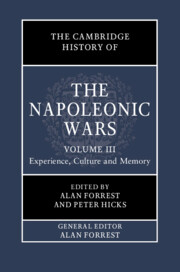Book contents
- The Cambridge History of the Napoleonic Wars
- The Cambridge History of the Napoleonic Wars
- The Cambridge History of the Napoleonic Wars
- Copyright page
- Contents
- Figures
- Maps
- Contributors to Volume III
- Introduction to Volume III
- Part I The Experience of War
- Part II The Experience of Imperial Rule
- Part III War, Culture and Memory
- Part IV The Aftermath and Legacy of the Wars
- 21 Demobilisation, Veterans and Civil Society after the Empire in France
- 22 Women, the Nation and the Collective Memory of the Napoleonic Wars
- 23 Jomini, Clausewitz and the Theory of War
- 24 The Legacy of Counter-revolution: Conservative Ideology and Legitimism in France
- 25 Bonapartism
- 26 The Legacy of the Wars for the International System
- 27 The Dislocation of the Global Hispanic World
- 28 Global Empire: Britain’s Century, 1815–1914
- 29 The Napoleonic Wars and Realms of Memory in Europe
- Bibliographic Essays
- Index
29 - The Napoleonic Wars and Realms of Memory in Europe
from Part IV - The Aftermath and Legacy of the Wars
Published online by Cambridge University Press: 05 August 2022
- The Cambridge History of the Napoleonic Wars
- The Cambridge History of the Napoleonic Wars
- The Cambridge History of the Napoleonic Wars
- Copyright page
- Contents
- Figures
- Maps
- Contributors to Volume III
- Introduction to Volume III
- Part I The Experience of War
- Part II The Experience of Imperial Rule
- Part III War, Culture and Memory
- Part IV The Aftermath and Legacy of the Wars
- 21 Demobilisation, Veterans and Civil Society after the Empire in France
- 22 Women, the Nation and the Collective Memory of the Napoleonic Wars
- 23 Jomini, Clausewitz and the Theory of War
- 24 The Legacy of Counter-revolution: Conservative Ideology and Legitimism in France
- 25 Bonapartism
- 26 The Legacy of the Wars for the International System
- 27 The Dislocation of the Global Hispanic World
- 28 Global Empire: Britain’s Century, 1815–1914
- 29 The Napoleonic Wars and Realms of Memory in Europe
- Bibliographic Essays
- Index
Summary
‘Napoleonic remembering’ did not wait for the end of the great enterprise linked to his name but emerged in the very years in which Napoleon was the prime actor, and Napoleon himself fostered it with deliberate awareness. From the very beginning, therefore, this remembering was linked to the events as they actually took place, not only the battles themselves but also the constructions that, emerging from military glory, became civil glories. Remembering and history intertwine, activating a hugely effective communicative mechanism that fixes the event in the memory while at the same time projecting towards events yet to happen. In the figurative arts, David’s Napoleon Crossing the Saint Bernard Pass immediately springs to mind, as does his even more famous painting of the Coronation and Consecration or Sacre, and above all the actual ‘campaign’ of memorial communication as revealed in the competition rules laid down for a painting of the terrible Battle of Eylau, which inspired the no less famous Napoleon on the Battlefield of Eylau by Antoine-Jean Gros.
- Type
- Chapter
- Information
- The Cambridge History of the Napoleonic Wars , pp. 588 - 609Publisher: Cambridge University PressPrint publication year: 2022



